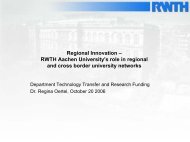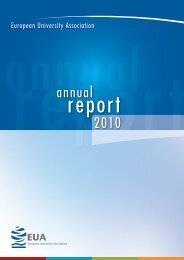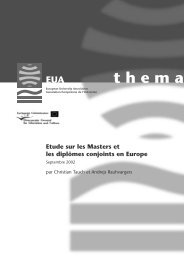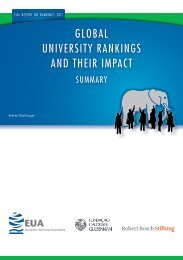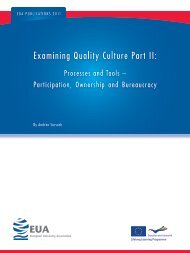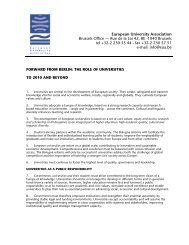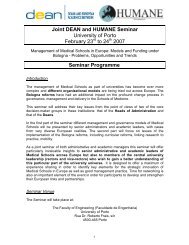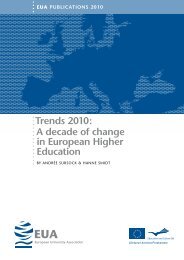Beiträge zur Hochschulforschung - European University Association
Beiträge zur Hochschulforschung - European University Association
Beiträge zur Hochschulforschung - European University Association
You also want an ePaper? Increase the reach of your titles
YUMPU automatically turns print PDFs into web optimized ePapers that Google loves.
26<br />
Thomas Estermann, Enora Bennetot Pruvot<br />
Public funding is not only diminishing in many countries, but also changing in the nature<br />
and form in which it is provided to universities. It is increasingly subject to conditions<br />
for its allocation or accompanied with growing accountability requirements. This has<br />
given public authorities increasing steering power over universities, which can have<br />
counterproductive effects as it can significantly contribute to reducing universities’<br />
autonomy and their capacity to manage their own funds freely. Such developments<br />
are worrisome as they can hinder universities’ capacity to successfully overcome the<br />
crisis. The universities’ ability to respond effectively to the ongoing economic situation<br />
has largely depended on the level of their institutional and, more especially, their fi-<br />
nancial autonomy.<br />
Major cuts to public funding of higher education were first observed in Latvia, where<br />
an initial cut of 48 per cent at the beginning of 2009 was followed by a further cut of<br />
18 per cent in 2010 stemming from the recommendations of the International Mon-<br />
etary Fund and the World Bank to reduce public funding of higher education drasti-<br />
cally. Although they follow several years of increases in university funding, the cuts<br />
have put serious pressure on the Latvian higher education system, demanding major<br />
changes and structural reforms to be introduced for the forthcoming years. Aca-<br />
demic salaries have been significantly cut (up to 30 per cent).<br />
In Italy, the 2010 financial law, which refers to the years 2011 to 2013, plans for a<br />
cumulative decrease of 14 per cent with respect to 2010. However, the cut will also<br />
have the effect of automatically diminishing universities’ income from tuition fees,<br />
which are limited to a maximum of 20 per cent of their total public funding. The situ-<br />
ation appears critical as some 25 universities already face a default risk in the near<br />
future. At the same time, a wide-ranging reform of the higher education system is<br />
being passed, which is to impact the way funding is delivered to universities.<br />
The situation is also critical in Greece, where the student population has been increas-<br />
ing while the government has been cutting higher education funding by up to 35 per<br />
cent over 2010 and 2011.<br />
England is also undergoing major changes at system level, following the release of<br />
the 2010 Comprehensive Spending Review. The higher education funding system is<br />
being changed significantly. While funding for research is settling, teaching funding<br />
through the Higher Education Funding Council for England will be reduced as of 2012.<br />
This follows previous cuts in 2010 in teaching budgets and in capital funding. But the<br />
situation in England is somewhat different from the other countries in this category.<br />
The reduction of public funding is meant to be covered by higher contributions from<br />
students (up to 9,000 pounds yearly for undergraduate courses), following the recom-<br />
mendations of the Browne Review in October 2010. Under the new system, students<br />
<strong>Beiträge</strong> <strong>zur</strong> <strong>Hochschulforschung</strong>, 33. Jahrgang, 2/2011



